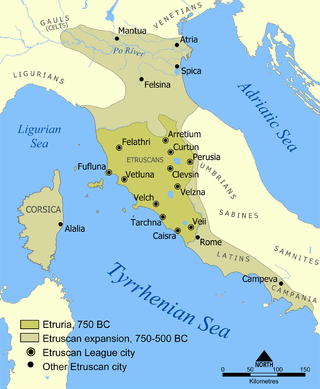
Etruria was a region of Central Italy delimited by the rivers Arno and Tiber, an area that covered what is now most of Tuscany, northern Lazio, and north-western Umbria.

Vergina is a small town in Northern Greece, part of Veria municipality in Imathia, Central Macedonia. Vergina was established in 1922 in the aftermath of the population exchanges after the Treaty of Lausanne and was a separate municipality until 2011, when it was merged with Veroia under the Kallikratis Plan.

A tumulus is a mound of earth and stones raised over a grave or graves. Tumuli are also known as barrows, burial mounds or kurgans, and may be found throughout much of the world. A cairn, which is a mound of stones built for various purposes, may also originally have been a tumulus.

Cortona is a town and comune in the province of Arezzo, in Tuscany, Italy. It is the main cultural and artistic centre of the Val di Chiana after Arezzo.

A gallery grave is a form of megalithic tomb built primarily during the Neolithic Age in Europe in which the main gallery of the tomb is entered without first passing through an antechamber or hallway. There are at least four major types of gallery grave, and they may be covered with an earthen mound or rock mound.

The province of Siena is a province in Tuscany, Italy. Its capital is the city of Siena.

The province of Lucca is a province in the Tuscany region of Italy. Its capital is the city of Lucca.
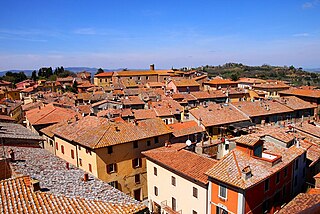
Chiusi is a town and comune in the province of Siena, Tuscany, Italy.

Kofun are megalithic tombs or tumuli in Northeast Asia. Kofun were mainly constructed in the Japanese archipelago between the middle of the 3rd century to the early 7th century CE.
Libyssa or Libysa (Λίβισσα), was a town on the north coast of the Sinus Astacenus in ancient Bithynia, on the road from Nicaea to Chalcedon. It was celebrated in antiquity as the place containing the tomb of the great Hannibal. In Pliny's time the town no longer existed, but the spot was noticed only because of the tumulus of Hannibal.
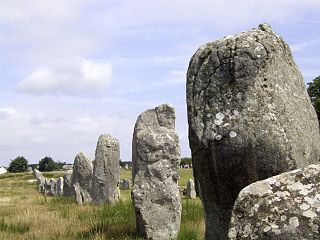
The Carnac stones are an exceptionally dense collection of megalithic sites near the south coast of Brittany in northwestern France, consisting of stone alignments (rows), dolmens, tumuli and single menhirs. More than 3,000 prehistoric standing stones were hewn from local granite and erected by the pre-Celtic people of Brittany and form the largest such collection in the world. Most of the stones are within the Breton municipality of Carnac, but some to the east are within neighboring La Trinité-sur-Mer. The stones were erected at some stage during the Neolithic period, probably around 3300 BC, but some may date to as early as 4500 BC.

Carmignano is a comune (municipality) in the province of Prato, part of the Italian region Tuscany. It is located about 20 kilometres (12 mi) west of Florence and about 10 kilometres (6 mi) southwest of Prato. It is the centre of the wine region of the same name.

The Locmariaquer megaliths are a complex of Neolithic constructions in Locmariaquer, Brittany. They comprise the elaborate Er-Grah tumulus passage grave, a dolmen known as the Table des Marchand and "The Broken Menhir of Er Grah", the largest known single block of stone to have been transported and erected by Neolithic people.
Rhoiteion was an ancient Greek city in the northern Troad region of Anatolia, also known as Ῥοίτιον ἄκρον. Its territory was bounded to the south and west by the Simoeis river and to the east by Ophryneion. It was located on the Baba Kale spur of Çakal Tepe north of Halileli and west of İntepe in Çanakkale Province, Turkey.
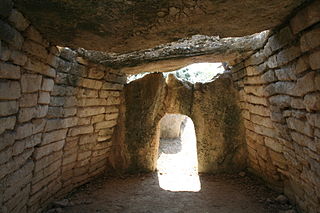
Gallardet Dolmen is a dolmen near the village of Le Pouget in Languedoc, France. It is a large tumulus, containing a 12 metre long alley. The main chamber, 6 metres long by 4 metres wide, is covered by three large capstones. The entrance is described as being like an "oven door", 2 metres high and 1 metre wide. The access corridor is 5 metres long and between 1 and 1.5 metres wide. The corridor leads to an outside chamber which is 2.5 metres long and the same in width.
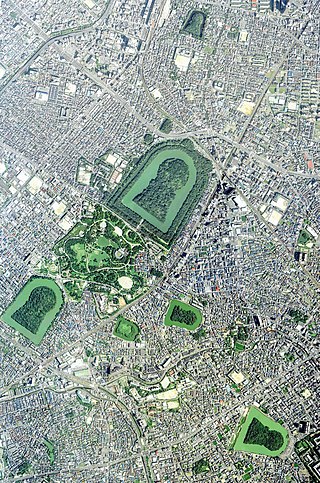
The Mozu Tombs are a group of kofun —megalithic tombs—in Sakai, Osaka Prefecture, Japan. Originally consisting of more than 100 tombs, only less than 50% of the key-hole, round, and rectangular tombs remain.

The Tomba della Mula is a beehive tomb in Sesto Fiorentino, near Florence, Central Italy, dating to the 7th century BC.

Gordion Museum is a museum in Turkey.

The Dolmen de la Pastora is a prehistoric passage grave at Valencina de la Concepción near Seville, Spain. It has been dated to the Chalcolithic Age.


















